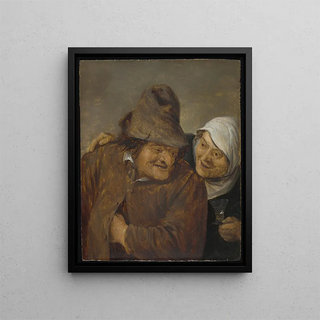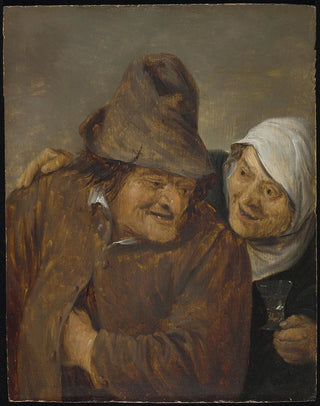Art print | Two peasants with a glass of wine - David Teniers the Younger


View from behind

Frame (optional)
In the fascinating world of 17th-century Flemish painting, the artwork "Two peasants with a glass of wine" by David Teniers the Younger stands out for its lively and intimate depiction of rural life. This scene, imbued with realism and human warmth, invites the viewer to immerse themselves in a moment of simple conviviality, where two peasants share a relaxing moment over a glass. The soft light bathing the composition emphasizes the tenderness of this interaction, while also revealing Teniers' technical mastery. Through this piece, the artist transports us to a world where everyday life takes on an almost poetic dimension, celebrating the beauty of fleeting moments in life.
Style and uniqueness of the artwork
David Teniers the Younger’s style is characterized by meticulous attention to detail and a warm color palette that evoke an atmosphere of conviviality. In "Two peasants with a glass of wine," the faces of the protagonists are filled with striking expressiveness, capturing authentic emotions. The texture of the clothing, the reflection of the wine in the glass, and the delicacy of the gestures demonstrate an in-depth observation of peasant life. Teniers does not merely depict a scene; he creates a visual narrative where each element contributes to the story told. The composition is also marked by a harmonious balance between the characters and the environment, reinforcing the idea of a shared space, of palpable intimacy. This work, through its apparent simplicity, reveals the complexity of human relationships and the importance of moments shared.
The artist and his influence
David Teniers the Younger, born in 1610 in Antwerp, is one of the most influential painters of his time, recognized for his ability to capture daily life with a unique sensitivity. Son of a painter, he was trained in a rich artistic environment, which shaped his distinctive style. Teniers established himself as a master of genre painting, where he combined realism and poetry. His influence extends far beyond his era, inspiring many artists across the centuries, who

Matte finish

View from behind

Frame (optional)
In the fascinating world of 17th-century Flemish painting, the artwork "Two peasants with a glass of wine" by David Teniers the Younger stands out for its lively and intimate depiction of rural life. This scene, imbued with realism and human warmth, invites the viewer to immerse themselves in a moment of simple conviviality, where two peasants share a relaxing moment over a glass. The soft light bathing the composition emphasizes the tenderness of this interaction, while also revealing Teniers' technical mastery. Through this piece, the artist transports us to a world where everyday life takes on an almost poetic dimension, celebrating the beauty of fleeting moments in life.
Style and uniqueness of the artwork
David Teniers the Younger’s style is characterized by meticulous attention to detail and a warm color palette that evoke an atmosphere of conviviality. In "Two peasants with a glass of wine," the faces of the protagonists are filled with striking expressiveness, capturing authentic emotions. The texture of the clothing, the reflection of the wine in the glass, and the delicacy of the gestures demonstrate an in-depth observation of peasant life. Teniers does not merely depict a scene; he creates a visual narrative where each element contributes to the story told. The composition is also marked by a harmonious balance between the characters and the environment, reinforcing the idea of a shared space, of palpable intimacy. This work, through its apparent simplicity, reveals the complexity of human relationships and the importance of moments shared.
The artist and his influence
David Teniers the Younger, born in 1610 in Antwerp, is one of the most influential painters of his time, recognized for his ability to capture daily life with a unique sensitivity. Son of a painter, he was trained in a rich artistic environment, which shaped his distinctive style. Teniers established himself as a master of genre painting, where he combined realism and poetry. His influence extends far beyond his era, inspiring many artists across the centuries, who






